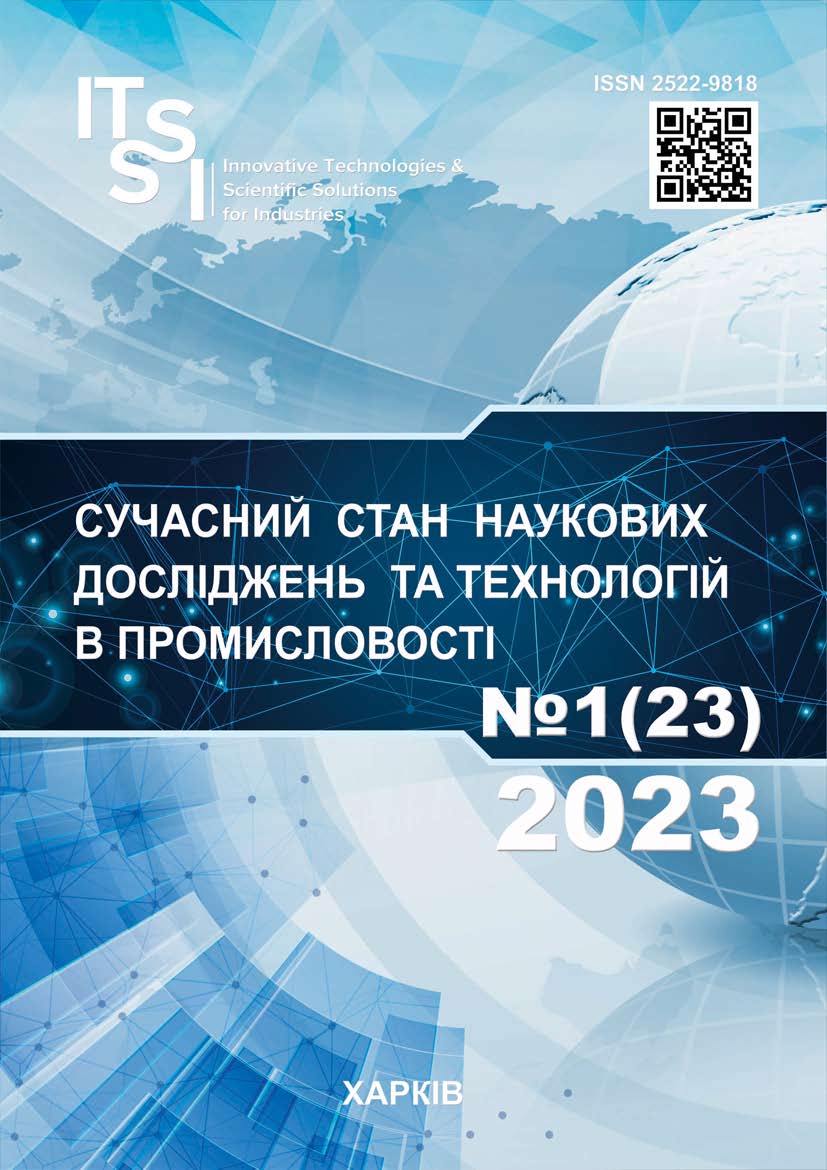АНАЛІЗ МЕТОДІВ ЗАХИСТУ АКУСТИЧНОЇ ІНФОРМАЦІЇ В СИСТЕМАХ КРИТИЧНОГО ЗАСТОСУВАННЯ
DOI:
https://doi.org/10.30837/ITSSI.2023.23.096Ключові слова:
акустична інформація; маскування акустичної інформації; технічний захист; криптографічний захист; стеганографічний (стеганофонічний) захист; модифікація мови; стиснення мовних повідомлень; комп’ютерні системиАнотація
Предмет дослідження – процес захисту акустичної інформації в комп’ютерних системах критичного застосування для забезпечення необхідного рівня безпеки системи. Метою статті є аналіз методів захисту акустичної інформації в комп’ютерних системах критичного застосування за допомогою маскування для забезпечення неможливості несанкційного доступу до системи. У роботі вирішуються такі завдання: проаналізовано програмно-технічне маскування мови; досліджено маскування мовних повідомлень з метою введення невпізнання; визначено особливості стиснення мовних повідомлень; вивчено приховану передачу акустичної інформації. Результатами роботи, отриманими за допомогою математичних методів перетворення інформації в комп’ютерних системах, є потенційно можливі методи маскування мовних повідомлень для забезпечення неможливості несанкційного доступу до системи. Аналіз функціонування запропонованих методів дав змогу сформувати конкретні висновки. Одним із перспективних напрямів захисту акустичної інформації в каналах зв’язку й виділених приміщеннях є створення та розвиток комп’ютеризованих систем маскування мови за умови їх сумісного використання з традиційними технологіями смислового захисту акустичної інформації, а саме засекречуванням мовних сигналів на основі криптографічних алгоритмів. Нині основними вимогами, що висуваються до систем, які забезпечують захист акустичної інформації в комп’ютерних системах критичного застосування, є швидкість і ефективність виконання різних процедур оброблення мовного сигналу з використанням стандартних недорогих технічних засобів комп’ютерної телефонії, зокрема: персонального комп’ютера, звукової карти, пристрою стику з телефонною лінією і/або модема. Задовольнити зазначені вимоги можна, застосовуючи цифрові методи динамічного спектрального аналізу-синтезу мовних і аудіосигналів. Вибір конкретних методів і засобів маскування мови як одного з видів смислового захисту акустичної інформації залежатиме від практичних вимог, що висуваються до системи мовного захисту й технічних характеристик каналу передачі акустичної інформації. Подальші дослідження буде присвячено аналізу можливого використання методів синтезу великих ансамблів квазіортогональних дискретних сигналів із поліпшеними ансамблевими, структурними й кореляційними властивостями для забезпечення вищих показників захищеності акустичних каналів у комп’ютерних системах критичного застосування.
Посилання
References
Kosenko, V. (2017), "Principles and structure of the methodology of risk-adaptive management of parameters of information and telecommunication networks of critical application systems", Innovative technologies and scientific solutions for industries, No 1 (1), Р. 75–81. DOI: https://doi.org/10.30837/2522-9818.2017.1.046
Kosenko, V. (2017), "Mathematical model of optimal distribution of applied problems of safety-critical systems over the nodes of the information and telecommunication network", Advanced Information Systems, Vol. 1, No. 2, P. 4–9. DOI: https://doi.org/10.20998/2522-9052.2017.2.01
Karen Bailey, Kevin Curran. Steganography. – BookSurge Publishing, 2005 р. – 118 р.
Johnson N., Duric Z., Jajodia S. Information Hiding: Steganography and Watermarking – Attacks and Countermeasures, New York – NY.: Kluwer Academic Pub, 2000 p. URL: https://link.springer.com/chapter/10.1007/0-387-25096-4_6
Elad Barkan. Instant Ciphertext-Only Cryptanalysis of GSM. Encrypted Communication. / Elad Barkan, Eli Biham, Nathan Keller. // Journal of Cryptology, Volume 21, Number 3, July 2008, Р. 392–429 (38).
J. Golic. Cryptanalysis of Alleged A5 Stream Cipher. – Proceedings of EUROCRYPT'97, LNCS 1233, Р. 239–255, Springer-Verlag 1997.
Alex Biryukov. Real Time Cryptanalysis of A5/1 on a PC. / Alex Biryukov, Adi Shamir, David Wagner – Springer Berlin / Heidelberg, 2001. − ISBN: 978-3-540-41728-6. URL: https://cryptome.org/a51-bsw.htm
Mozhaiev O. Development of a method for determining the general criteria of abnormal behavior of a computer system based on the improved criterion of uniformity of input data samples / Mozhaiev O., Semenov, S., Kuchuk, N., Mozhaiev, M., Tiulieniev, S., Gnusov, Y., Yevstrat, D., Chyrva, Y., Kuchuk, H.// Eastern-European Journal of Enterprise Technologies, 6 (4 (120)), P. 40–49. DOI: https://doi.org/10.15587/1729-4061.2022.269128
Mozhaiev O. Crypto-resistant methods and random number generators in internet of things (iot) devices/ Mozhaiev O., Klimushyn P., Solianyk T., Gnusov Y., Manzhai O., Svitlychnyi V. // Innovative technologies and scientific solutions for industries, 2022 № 2 (20), P. 22–34. DOI: https://doi.org/10.30837/ITSSI.2022.20.022
Mozhaiev O. Potential application of hardware protected symmetric authentication microcircuits to ensure the security of internet of things/ Mozhaiev O, Klimushyn P., Solianyk T., Kolisnyk T. // Advanced Information Systems, 2021. Vol. 5, No 3. P. 103–111. DOI: https://doi.org/10.20998/2522-9052.2021.3.14
Klimushyn, P., (2021), "Hardware support procedures for asymmetric authentication of the internet of things",/ Klimushyn, P., Solianyk, T., Mozhaev, O., Nosov, V., Kolisnyk, T., Yanov V// Innovative Technologies and Scientific Solutions for Industries, No. 4 (18), P. 31-39. DOI: https://doi.org/10.30837/ITSSI.2021.18.031
J. Friedrich, G. Miroslav, R. Du. Reliable Detection of LSB Steganography in Color and Grayscale Images. Binghampton, New York: SUNY, 2001. URL: http://www.ws.binghamton.edu/fridrich/research/acm_2001_03.pdf
J. Fridrich, R. Du, and L. Meng, "Steganalysis of LSB Encoding in Color Images", ICME 2000, New York City. DOI: https://doi.org/10.1109/ICME.2000.871000
W. Brock. W. Dechert and J. Scheinkman. "A test for independence based on the correlation dimension", Working Paper, University of Wisconsin, 1987. DOI: https://doi.org/10.1177/1536867X211025796
Wu H. C., Wu N. I., Tsai C. S., Hwang M. S. Image Steganographic Scheme Based on Pixel-Value Differencing and LSB Replacement Methods // IEEE Transactions on Image and Signal Processing, 2005. – № 5. – P. 611–615. DOI: https://doi.org/10.1049/IP-VIS:20059022
##submission.downloads##
Опубліковано
Як цитувати
Номер
Розділ
Ліцензія

Ця робота ліцензується відповідно до Creative Commons Attribution-NonCommercial-ShareAlike 4.0 International License.
Наше видання використовує положення про авторські права Creative Commons для журналів відкритого доступу.
Автори, які публікуються у цьому журналі, погоджуються з наступними умовами:
Автори залишають за собою право на авторство своєї роботи та передають журналу право першої публікації цієї роботи на умовах ліцензії Creative Commons Attribution-NonCommercial-ShareAlike 4.0 International License (CC BY-NC-SA 4.0), котра дозволяє іншим особам вільно розповсюджувати опубліковану роботу з обов'язковим посиланням на авторів оригінальної роботи та першу публікацію роботи у цьому журналі.
Автори мають право укладати самостійні додаткові угоди щодо не комерційного та не ексклюзивного розповсюдження роботи у тому вигляді, в якому вона була опублікована цим журналом (наприклад, розміщувати роботу в електронному сховищі установи або публікувати у складі монографії), за умови збереження посилання на першу публікацію роботи у цьому журналі.
Політика журналу дозволяє і заохочує розміщення авторами в мережі Інтернет (наприклад, у сховищах установ або на особистих веб-сайтах) рукопису опублікованої роботи, оскільки це сприяє виникненню продуктивної наукової дискусії та позитивно позначається на оперативності та динаміці цитування опублікованої роботи.














